What Is “Human-Grade Dog Food”? (Definition, Standards & Label Rules)
Definition: What “Human-Grade Dog Food” Really Means
“Human-Grade Dog Food” is not a feel-good slogan. It’s a whole-product claim that covers every step—ingredient sourcing, cooking facility, sanitation, packaging, storage, and transport. To qualify, all ingredients must be human-edible and the finished food must be produced under human-food regulations (e.g., CGMPs and preventive controls). If a label only says “made with human-grade ingredients” but the entire product wasn’t handled as human food from start to finish, the claim isn’t compliant.
The Full-Product Standard (Not Just Ingredients)
- Ingredients: Every component is human-edible (no feed-grade shortcuts).
- Facility: Cooked in a human-food kitchen, not a feed mill.
- Process controls: Documented sanitation, hazard analysis, and preventive controls.
- Transport & storage: Temperature and handling maintain human-edible status.
- Labeling: Must still state it’s dog food and include an AAFCO adequacy statement.
Human-Edible vs. “Human-Grade Ingredients” vs. Whole-Product Claims
- Human-edible: Ingredient-level status suitable for people.
- “Human-grade ingredients”: Often misused if the final food isn’t kept human-edible through production and logistics.
- Whole-product “Human-Grade Dog Food”: The only meaningful claim—ingredients + facility + handling all meet human-food rules.
Regulatory Oversight: FDA, AAFCO, and USDA
- FDA/CVM (Federal): Regulates pet food safety and truthful labeling; expects safe, sanitary production and accurate claims.
- AAFCO (Model rules): Defines how “human-grade” may be used on labels and what documentation regulators can request.
- USDA (Where applicable): Oversees certain human-food facility processes (e.g., meat inspection) that brands often reference (“USDA-inspected kitchen”).
Why Facilities, Handling & Transport Matter in Human-Grade Dog Food
Starting with beautiful, human-edible chicken and then cooking it in a feed-grade plant—or shipping it warm without logs—breaks the chain. True Human-Grade Dog Food maintains human-edible status from supplier to sealed pouch, with:
- Human-food kitchens and trained staff,
- Lot codes, traceability, and batch testing,
- Cold-chain integrity and documented storage/transport practices.
Quick Label Checks: Red Flags vs. Green Flags
- Green flags: “Prepared in human-food facilities,” AAFCO complete & balanced, feeding-trial or digestibility data, batch-testing transparency.
- Red flags: “Made with human-grade ingredients” (only), no AAFCO statement, vague facility info, or no documentation on process and transport.
Real-World Benefits of Human-Grade Dog Food (Nutrition, Safety, Palatability)
Why Processing Matters in Human-Grade Dog Food
Most Human-Grade Dog Food is lightly cooked or gently processed—think sous-vide, air-dried, or dehydrated—rather than extruded at ultra-high heat like standard kibble. Gentler methods help protect heat-sensitive nutrients and can improve digestibility. Leading fresh brands pair this with clear AAFCO complete & balanced statements and input from veterinary nutritionists, so the bowl delivers nutrients dogs can actually absorb. In day-to-day terms, owners often see steadier energy, glossier coats, and smaller, more regular stools after moving from low-quality feed-grade diets to genuine human-grade meals. If you want convenience without a freezer takeover, shelf-stable human-grade formats (dehydrated, air-dried, or “fresh-dry”) offer real-food ingredient lists with better portability.
Safety & Transparency Wins with Human-Grade Dog Food
A core advantage of Human-Grade Dog Food is the safety system behind it. Reputable brands source from human food suppliers, cook in human-food facilities, and run preventive controls you’d expect for people—sanitation programs, supplier verification, temperature logs, and batch testing for pathogens. Many publish sourcing maps, kitchen details, and even digestibility or feeding-trial summaries. When a company mentions USDA-inspected or USDA Process Verified kitchens—or dual registration as both human and animal food facilities—it’s signaling the infrastructure needed to maintain human-edible status from receiving dock to sealed pouch.
Palatability: Getting Picky Eaters to the Bowl
Freshly cooked meat and vegetables, visible textures, and natural gravies make Human-Grade Dog Food a go-to for picky eaters, underweight rescues, and senior dogs with dental wear. A quick warm-up (never in a sealed pack) releases aroma and boosts interest. If freezer space is tight, dehydrated or air-dried human-grade options rehydrate to a stew-like consistency dogs love—great for travel or sitters. Prefer scoop-and-serve? “Fresh-dry” styles deliver human-grade ingredient decks in a tidy, crunchy format.
Top Palatability Tweaks (Quick Wins)
- Warm the portion slightly to bloom aroma.
- Add a splash of warm water or broth-style topper.
- Choose single-protein recipes for sensitive stomachs.
- Mix 25–50% fresh human-grade with a trusted base to ease the switch.
Digestibility & Bioavailability: Why Lightly Cooked Often Wins
Light cooking can denature proteins just enough to aid digestion while preserving key nutrients—one reason Human-Grade Dog Food often tests as highly digestible. Look for brands that publish AAFCO feeding trials or independent digestibility data; claims like “clinically proven highly digestible” usually mean they invested in third-party or university protocols. By contrast, high-heat extrusion makes shelf-stable pellets fast, but may reduce availability of some heat-sensitive compounds. Add pre-portioned packs, and you also curb the most common feeding mistake: over-portioning.
Fewer Fillers, More Clarity in Human-Grade Labels
Authentic Human-Grade Dog Food keeps ingredient lists short and specific: named meats and organs, recognizable produce, and clear fats—not vague “meat by-product meal” or “animal digest.” Some brands even balance certain recipes to AAFCO without synthetic premixes (challenging, but appealing to purists). Whether or not a premix is used, the priority is transparency: supplier identity, cooking method, and an unmistakable AAFCO adequacy statement for your dog’s life stage.
Taste & Texture Options That Reduce GI Drama
Texture matters. Soft, moist meals help olders and picky eaters; dehydrated human-grade foods let you choose the thickness after rehydration; air-dried/fresh-dry formats mimic kibble ease while keeping real-food vibes. For sensitive dogs, start with a single-protein, single-starch recipe (e.g., turkey + rice or sweet potato) to limit variables. Pair that with a gradual transition and you’ll keep stools consistent while dialing in flavor preference.
Consistency Across Batches: Kitchens, QC & Traceability
Serious Human-Grade Dog Food makers operate like human kitchens: lot codes, environmental monitoring, and documented QC to deliver the same bowl every time. Public quality/safety pages, posted feeding-trial certificates, and traceability tools (sometimes lot-level ingredient lookups) aren’t decoration—they’re proof the brand can reproduce results shipment after shipment. For allergy dogs or long-term feeding plans, that repeatability is gold.
Drawbacks, Myths & Marketing Traps
The Real Cost of Human-Grade Dog Food: Value vs. Hype
Human-Grade Dog Food often costs more because it’s made in human-food facilities with stricter documentation, sanitation, and sourcing standards. If your dog already thrives on a well-made, AAFCO-complete kibble, you don’t have to switch. The upgrade is about transparency, safety controls, and digestibility—not prestige. Judge value by outcomes you can see and track: stool quality, skin/coat, energy, body condition, appetite, and how consistently your dog eats the food. If those markers don’t improve, the pricier bowl may not be worth it for your household.
When Paying More Makes Sense
- You want ingredient traceability, batch testing, and clear AAFCO adequacy.
- Your dog is picky, underweight, or has sensitive GI and responds to lightly cooked textures.
- You need pre-portioned packs to curb overfeeding and manage weight precisely.
Budget Moves Without Sacrificing Quality
- Go partial fresh (25–50% Human-Grade Dog Food + quality kibble).
- Choose chicken/turkey recipes over pricier proteins.
- Use samplers/intro discounts and adjust delivery cadence.
- Consider vetted DIY nutrient kits if you like to cook at home.
Myth: Grain-Free Human-Grade Dog Food Is Always Better
“Grain-free” isn’t an automatic upgrade. Most dogs digest well-cooked grains (rice, oats, barley, quinoa) just fine, and some actually do better with them—especially active dogs that benefit from steady glycogen. What matters most is complete & balanced nutrition, digestible protein, and correct calories for your dog.
When Grains Help
- Dogs needing steady energy for training or work.
- Sensitive GI pups who tolerate rice/oats better than heavy legume loads.
- Owners seeking single-starch clarity (e.g., turkey + rice) for troubleshooting.
If You Suspect a Grain Issue
- Try a single-protein, single-starch formula and transition slowly.
- Track stools, itch, and energy for 14 days before switching again.
- Confirm the recipe’s AAFCO life-stage fit (growth, all life stages, or maintenance).
Can “Human-Grade Kibble” Be Real?
Traditional kibble is extruded in feed-grade plants; maintaining human-edible status end-to-end is uncommon. That’s why the more realistic path is kibble alternatives that honor the human-grade spirit without extrusion.
Kibble Alternatives That Keep Human-Grade Intent
- Air-dried: Gently dried, jerky-like pieces; shelf-stable; high palatability.
- Dehydrated: Pantry-friendly flakes you rehydrate with warm water.
- “Fresh-dry”/Baked Clusters: Low-and-slow drying or baking for a crunchy, scoopable format.
Always verify AAFCO completeness and, where available, digestibility/feeding-trial data.
Marketing Red Flags in Human-Grade Dog Food Claims
Claim creep is real. Some labels hint at human-grade without meeting the whole-product bar.
- Green flags: “Prepared in human-food facilities,” clear AAFCO statement, batch testing, traceability, and sourcing details.
- Red flags: “Made with human-grade ingredients” (only), no facility details, no transport/handling info, or vague protein names (“meat meal,” “animal digest”).
Questions to Email Support (Copy/Paste)
- “Is this a whole-product human-grade food (ingredients and facility/handling)?”
- “Where is it produced, and under what registrations?”
- “Do you have an AAFCO adequacy statement for this recipe and life stage?”
- “Do you perform batch pathogen testing or publish digestibility/feeding-trial data?”
Air-Dried, Dehydrated & Gently Cooked: Smarter Shelf-Stable Options
Between perishable fresh pouches and dry pellets lies a sweet spot: dehydrated (rehydrate to serve), air-dried bites, and baked clusters. These methods use lower temperatures than extrusion, often preserve aroma/texture, and cut freezer reliance and shipping weight. They’re ideal for travelers, small freezers, and owners who want Human-Grade Dog Food benefits with pantry convenience.
Who Should Choose Shelf-Stable Human-Grade?
- Frequent travelers or sitter-heavy households.
- Small fridges/freezers or limited storage space.
- Dogs that like a crunchy bowl but need clean, human-grade ingredients.
Tip: Rehydrate dehydrated food to your dog’s preferred thickness, and add a splash of warm water to air-dried/clusters to boost aroma without turning the meal soupy.
(*) Top 10 Best Large Dog Food Dispensers in 2026 Reviews & Guide
(**) Top 5 Best Wellness CORE Dog Food Reviews (Updated Guide)
(***) Top 10 Best Dog Grooming Harness Reviews (Updated Guide)
What You’ll Really Spend (2025–2026 Pricing Benchmarks & Tips)
Human-Grade Dog Food: Quick Cost Snapshot
Expect Human-Grade Dog Food to land above premium kibble because you’re paying for human-food facilities, documented safety, and fresher inputs. Real-world owner reports and brand FAQs typically show small dogs at the low end and giant breeds at the high end. Use the brand quotes as starting points and always price your dog’s exact weight, activity, and recipe on the product page.
The Farmer’s Dog (Fresh, Pre-Portioned)
- Advertised from: ~$2/day
- Observed range: ~$2.49–$21.42/day (size, recipe, plan)
- Typical medium dog (26–50 lb): ~$3–$8/day
- Notes: Pre-portioned packs curb overfeeding; beef/novel proteins cost more. Running 25–50% fresh with a quality base kibble preserves many Human-Grade Dog Food benefits while trimming spend.
JustFoodForDogs (Fresh, PantryFresh, DIY Kits)
- Small dogs (indicative): ~$4–$7/day (Fresh or PantryFresh)
- Medium/Large dogs: ~$6–$15+/day depending on calories and richer proteins
- DIY Nutrient Kits (home-cooked): often ~$2–$6/day (groceries + kit; follow recipes exactly)
- Notes: You’re also paying for vet-formulated recipes, published feeding trials/digestibility data, and flexible formats (PantryFresh for travel; DIY for budget).
Health Extension Gently Cooked Beef & Potato (9-oz pouches)
Notes: Beef often prices higher than chicken/turkey. As a topper (25–50% of the bowl), it boosts palatability and “real-food” texture at a lower daily cost—while keeping your Human-Grade Dog Food goals intact.
- Use: Complete meal or topper
- Typical pricing: ~$3.75–$5.50 per pouch (varies by retailer)
- Quick math: Cost/day ≈ (your dog’s calories ÷ kcal per pouch) × price per pouch
- Ballpark full-feed: Toy $2–$5 • Small $4–$7 • Medium $7–$10 • Large $10–$16 • Giant $14–$22+
What it is: Bowl-ready, gently cooked Human-Grade Dog Food in 9-oz pouches (case of 10). Works as a complete meal or a super-tasty topper.
How to price it fast:
- Find the label’s Calories (ME) per pouch.
- Daily pouches ≈ your dog’s calories ÷ kcal per pouch.
- Cost/day = pouches × price per pouch.
Example math (swap in your label/price): using ~380 kcal/pouch and $4.50 per pouch.
| Dog Size | Typical Calories/Day* | Pouches/Day | Est. $/Day |
|---|---|---|---|
| Toy (≈8 lb) | 220 | 0.6 | $2.70 |
| Small (≈15 lb) | 400 | 1.1 | $4.95 |
| Medium (≈30 lb) | 800 | 2.1 | $9.45 |
| Large (≈60 lb) | 1,300 | 3.4 | $15.30 |
| Giant (≈90 lb) | 1,800 | 4.7 | $21.15 |
*Calorie needs vary by age, activity, and body condition; ask your vet.
Ways to save:
- Start with chicken/turkey recipes (usually cheaper than beef).
- Use as a topper (25–50% of the bowl) to cut daily cost while boosting palatability.
- Order larger cases and enable autoship promos when available.
Good fit for: picky eaters, dogs needing softer textures, and pet parents who want a transparent, gently cooked option without freezer math.
Price-Per-Day by Dog Size (Fresh vs. Shelf-Stable Human-Grade)
- Toy (≤10 lb): Fresh $2–$5/day · Air-dried/dehydrated $1–$3/day
- Small (11–25 lb): Fresh $3–$7/day · Air-dried/dehydrated $2–$5/day
- Medium (26–50 lb): Fresh $4–$10/day · Air-dried/dehydrated $3–$7/day
- Large (51–90 lb): Fresh $7–$15/day · Air-dried/dehydrated $5–$10/day
- Giant (90+ lb): Fresh $10–$20+/day · Air-dried/dehydrated $8–$15/day
What Drives the Price of Human-Grade Dog Food Up (or Down)
- Protein choice: Beef, lamb, and novel proteins > chicken/turkey.
- Recipe richness: Higher meat/fat density costs more per calorie.
- Format: Fresh (cold-chain shipping) > dehydrated/air-dried (pantry-friendly).
- Shipping cadence/pack size: Smaller, frequent boxes cost more per pound.
- Add-ons: Extra treats, toppers, and supplements nudge totals higher.
Save More: Subscription Discounts, Samplers & Mix-In Strategies
- Intro promos & autoship: First-box deals (often 30–60% off) + subscribe-and-save.
- Samplers/trials: Test palatability before filling your freezer.
- Partial fresh feeding: Make 25–50% of the bowl Human-Grade Dog Food and keep a high-quality base kibble—most families see the palatability/digestibility wins at a friendlier monthly spend.
- Choose economical proteins: Start with chicken or turkey.
- Optimize shipping: Larger boxes, less often—if your freezer allows.
DIY Nutrient Blends & Partial Fresh Feeding: Budget-Friendly Paths
If you like to cook, use tested recipes plus a brand’s nutrient blend to keep meals complete & balanced. Measure proteins, fats, and carbs precisely (weights, not eyeballs), and follow the cooking method specified. If full DIY feels like too much work, stick with a hybrid bowl (e.g., 50/50 fresh + kibble) to capture most benefits of Human-Grade Dog Food while keeping costs predictable.
A Simple Cost Table (Monthly Estimates by Size & Style)
| Dog Size | Fresh Human-Grade (Full Feed) | Air-Dried/Dehydrated Human-Grade (Full Feed) | Hybrid (50% Fresh + 50% Quality Kibble) |
|---|---|---|---|
| Toy (≤10 lb) | $60–$150 | $30–$90 | $40–$80 |
| Small (11–25 lb) | $90–$210 | $60–$150 | $60–$120 |
| Medium (26–50 lb) | $120–$300 | $90–$210 | $80–$160 |
| Large (51–90 lb) | $210–$450 | $150–$300 | $130–$260 |
| Giant (90+ lb) | $300–$600+ | $240–$450 | $180–$350 |
Notes: Ranges reflect 2025–2026 market observations. Protein choice, format, and delivery cadence swing totals. Always price your dog’s exact profile on the brand site.
Mini Formula: Ballpark Your Dog’s Monthly Budget
- Find your dog’s daily price bracket above (by size + format).
- Multiply by 30 days.
- Adjust for protein (±10–25%) and promos (−10–40%).
- If doing partial fresh, multiply the fresh portion by 0.25–0.5 and add your base food cost.
This structure keeps your Human-Grade Dog Food plan predictable—and sustainable.
How to Read a Human-Grade Label (Like a Pro)
Start Here: Find the AAFCO Nutritional Adequacy Statement
This one line tells you if the recipe is “complete & balanced” and for which life stage (e.g., maintenance, all life stages, or growth including large-size dogs). If it’s missing or vague, pause your purchase.
What the Statement Should Include
- The intended species (dog).
- The life stage (maintenance, growth, all life stages).
- The validation method: formulated to meet AAFCO or validated by feeding trials.
Confirm Species & Intended Use
Even the best Human-Grade Dog Food must clearly say “dog food” or “for dogs.” Avoid products that only say “pet food” without specifying species, or that market as toppers only unless you plan to use them that way.
Ingredient Panel: Read It Like a Chef
Scan top to bottom; ingredients are listed by weight before cooking.
Named Proteins & Fats (Green Flags)
- “Chicken thigh,” “beef heart,” “salmon oil” → clear, specific, species-named.
- Avoid vague terms like “meat meal” or “animal fat.”
Produce & Starches You Recognize
- Whole-food carbs (oats, brown rice, quinoa, sweet potato).
- Functional veggies/fruit (carrots, spinach, blueberries) for micronutrients and fiber.
Vitamins/Minerals & Premix Clarity
- Many complete diets use a vitamin–mineral premix (normal).
- Some recipes meet AAFCO without a premix—fine if the brand shows the math.
- Either way, the AAFCO adequacy must still be explicit.
Verify the “Human-Grade” Claim (Whole Product, Not Just Ingredients)
True Human-Grade Dog Food means human-edible ingredients and human-food processing, storage, and transport—end to end.
Facility, Handling & Transport Proof
- Cooked in human-food facilities (often USDA-inspected or Process Verified).
- Preventive controls and sanitation procedures.
- Cold-chain or handling records that preserve human-edible status.
Acceptable Receipts
- A Quality/Safety page detailing kitchens and controls.
- Feeding-trial or digestibility summaries (bonus).
- COAs or statements about batch pathogen testing.
Green-Flag vs. Red-Flag Claims
- Green flags: “Prepared in human-food kitchens,” AAFCO complete & balanced, feeding trial certificates, USDA Process Verified, batch testing, traceable sourcing.
- Red flags: “Made with human-grade ingredients” (only), no AAFCO statement, vague proteins (“meat meal”), no facility details, evasive answers from support.
Facility & Process Clues to Spot Fast
Look for phrases like “USDA-inspected kitchen,” “FDA-registered human food facility,” and “preventive controls.” Lot codes on pouches (traceability) and occasional COAs suggest a real QA system—not just marketing.
How to Verify: Websites, COAs, Feeding Trials & Batch Tests
- Website: Check Quality/Safety, Feeding Trials, and kitchen details pages.
- Label: Confirm AAFCO adequacy and clear ingredient naming.
- Support: Ask for trial certificates, digestibility data, or COAs.
- Reviews: Use third-party reviews for price/context, but validate science claims with brand documents.
Copy/Paste Email Template
Hi Team,
Before I order, can you confirm whether this recipe is a whole-product Human-Grade Dog Food under AAFCO’s definition (ingredients and facility/handling)? Also, please share the AAFCO nutritional adequacy statement, any feeding-trial/digestibility results, and a brief note on batch pathogen testing. Thank you!
Quick Label Checklist (1-Minute Audit)
- ✅ Species & purpose say dog food.
- ✅ AAFCO statement lists the life stage and validation method.
- ✅ Specific meats/fats, recognizable produce, clear supplement listing.
- ✅ Human-grade proof: human-food facility + handling details.
- ✅ Traceability/QA: lot codes, batch testing, or COAs available.
Cheat Sheet: What You Want to See (At a Glance)
| Label Element | What You Want to See | Why It Matters |
|---|---|---|
| AAFCO Statement | “Complete & balanced for [life stage] … by [formulation/feeding trials]” | Confirms daily suitability and validation method |
| Species | “Dog food” / “For dogs” | Legal clarity; no species ambiguity |
| Protein Naming | “Chicken thigh,” “Beef liver,” “Salmon oil” | Transparency; avoids vague inputs |
| Human-Grade Proof | Human-food facility + handling/transport details | Whole-product claim, not just ingredients |
| QA Evidence | Batch testing, traceability, COAs, trial/digestibility data | Shows real quality systems, not just marketing |
Use this framework every time you shop, and you’ll separate true Human-Grade Dog Food from clever packaging in under a minute.
Transitioning Safely to Human-Grade Dog Food (10-Day Plan + Troubleshooting)
Why a Gradual Switch Matters
Switching to Human-Grade Dog Food is simple, but your dog’s gut still needs a ramp. A slow transition lets digestive enzymes and the microbiome adjust to new fiber, fat, and moisture levels. It also gives you clean signal on what’s working—without the noise of a sudden overhaul. Keep two pillars in mind: consistency (same meal times, measured portions, no extra table scraps) and data (quick notes on stool score 1–5, appetite, gas, itch, and energy). If your pup has a GI history, is coming off antibiotics, or has pancreatitis risk, extend the timeline (e.g., 14 days) and begin with a single-protein, lower-fat recipe. Senior dogs often benefit from slightly warmed, softer textures; puppies need closer calorie checks and a recipe labeled for growth or all life stages (verify the AAFCO statement first). Red flags like repeated vomiting, black/tarry stool, or marked lethargy warrant a vet call; brief soft stools during the switch are common and usually self-resolve.
The 10-Day Transition Plan (Fresh, Gently Cooked, or Rehydrated)
Follow these ratios per meal; advance only if stools and appetite look good:
- Days 1–2: 10–20% new • 80–90% old
- Days 3–4: 30–40% new • 60–70% old
- Days 5–6: 50–60% new • 40–50% old
- Days 7–8: 70–80% new • 20–30% old
- Days 9–10: 90% new • 10% old
- Day 11+: 100% new
Pro Moves for Smoother Switches
- Warm, don’t cook: Empty into a bowl and gently warm or use a warm-water bain-marie (never microwave sealed pouches).
- Weigh portions: Fresh food is moisture-dense; “eyeballing” often overfeeds.
- Pumpkin assist: If stools loosen, step back a phase for 24–48 hours and add 1 tsp (small dogs) to 1 Tbsp (large dogs) plain pumpkin—if your vet agrees.
- Mini-meals: Split daily calories into 3 smaller meals for very sensitive dogs.
- Simplify variables: Start with a single protein + single starch (e.g., turkey + rice).
- Confirm completeness: Ensure the recipe carries an AAFCO adequacy statement for your dog’s life stage.
Reading Your Dog’s Feedback (Stools, Energy, Skin, Gas)
Use your notes to guide pace and recipe choice.
Stools
Ideal stools are formed, easy to pick up, and consistent in color. Mild softening on Days 3–6 is common. Persistent watery stool, mucus, or blood is not normal—pause and call your vet. Many owners notice smaller, less frequent stools on highly digestible human-grade diets.
Energy & Appetite
Energy should hold steady or improve when calories are matched. A sudden dip often means underfeeding—increase portion gradually. Picky eaters usually perk up with warm, broth-forward meals.
Itching & Skin
Minor fluctuations can occur during protein changes. Give a stable trial of 10–14 days unless you see hives, facial swelling, or severe ear/skin reactions—those require immediate attention.
Gas & Bloating
Transient gas can reflect microbiome adjustment. Slow the transition, avoid extra treats, and keep recipes simple (single starch/protein) until things settle.
Hydration & Body Condition
Fresh food brings moisture; less drinking can be normal. Check body condition weekly: ribs palpable with a thin fat cover, visible waist from above, abdominal tuck from the side. Adjust calories before changing formulas.
Mixing Strategies: Fresh + Kibble Without GI Drama
You don’t have to go “all-fresh” to capture benefits of Human-Grade Dog Food. Smart blends improve palatability and digestibility while controlling costs.
Two Easy Models
- Topper: 25–30% human-grade + 70–75% complete kibble.
- Half-and-Half: 50% human-grade + 50% complete kibble.
Key Rules for Hybrid Bowls
- Both foods must be complete & balanced for your dog’s life stage (check AAFCO on each).
- Do the calorie math: Sum calories from both components; adjust to maintain ideal body condition.
- Blend thoroughly: Mix warm fresh food into kibble so each bite is consistent—prevents cherry-picking and reduces GI surprises.
- Rehydrate right: For dehydrated diets, add warm water, stir, and let sit a few minutes so starches bloom. For air-dried/clusters, a splash of warm water boosts aroma and reduces crumbling.
For Sensitive Stomachs
Start with a turkey or chicken single-protein topper and a grain-inclusive base if tolerated (e.g., rice/oats). Hold the recipe steady for 14 symptom-free days before introducing variety.
Hydration, Temperature & Routine (Daily Best Practices)
Structure makes the gut happy.
- Serve slightly warm: Room temp to gently warm enhances aroma; never scalding hot.
- Food safety rhythm: Thaw in the refrigerator; use opened pouches within 3–4 days; follow use-by dates.
- Set mealtimes: Two consistent feedings; remove leftovers after 10–15 minutes.
- Separate pets: Feed in different spots to prevent resource guarding and to track intake.
- Travel smart: Keep a shelf-stable human-grade option (dehydrated or air-dried) for trips so you don’t retrain the gut every time.
- Treat math: Cap treats at ≤10% of daily calories. If you add jerky or dehydrated veggies, subtract a few grams from dinner—small dogs are easy to overfeed.
When to Slow Down—or Call the Vet
- Slow the plan if stools soften more than 24–48 hours or gas increases—drop back one step.
- Call your vet for repeated vomiting, black/tarry stool, blood, marked lethargy, refusal to eat >24 hours, or sudden weight loss.
- Special cases: Puppies, olders, and dogs on meds may need longer transitions and closer calorie monitoring.
With this structure—and an AAFCO-complete Human-Grade Dog Food—you’ll capture the digestibility and palatability wins while keeping bellies happy from Day 1 to Day 11 and beyond.
Selection Criteria for the Top 10 Human-Grade Dog Food Brands (2026)
Baseline Requirement: A True Whole-Product “Human-Grade Dog Food” Claim
- Whole product, not ingredients only: Every input is human-edible and the entire process (manufacturing, storage, transport) follows human-food rules.
- Label truthfulness: Clear species (“dog food”) and a visible AAFCO nutritional adequacy statement for the intended life stage.
- Proof on site: Pages that explain kitchens, registrations, handling, and transport—not just a tagline.
Nutrition Validation: AAFCO Feeding Trials & Digestibility Data
- Minimum: “Formulated to meet AAFCO …” for the correct life stage.
- Best-in-class: AAFCO feeding trials and/or independent digestibility studies posted or summarized publicly.
- What we look for: Recipe-level calories, macros, and (ideally) amino acid and mineral detail.
Transparency & QA: Batch Testing, COAs, Traceability
- Quality signals: Lot codes, pathogen testing, certificates of analysis (COAs), and supplier transparency.
- Support responsiveness: Direct answers to “Is this a whole-product Human-Grade Dog Food under AAFCO?” plus documents on request.
Format Diversity & Accessibility (Fresh + Shelf-Stable)
- Fresh/gently cooked for palatability and digestibility.
- Dehydrated/air-dried/fresh-dry for pantry ease, travel, and small freezers.
- Puppy/ALS coverage: Options that include growth (and “growth of large size dogs” where applicable).
Results per Dollar: Value, Not Just Price
- We weigh ingredient quality, kitchen controls, and evidence (trials/digestibility) against daily cost.
- Bonus points for pre-portioned packs (portion accuracy) and strong customer care.
Ethics & Sustainability (Sourcing & Packaging)
- Documented sourcing standards (humane, traceable fisheries, country-of-origin).
- Lower-impact options: Recyclable/minimal packaging; lighter, shelf-stable formats that still meet whole-product human-grade and AAFCO.
Quick Vetting Checklist (Copy/Paste)
- ✅ Whole-product Human-Grade Dog Food (ingredients and facility/handling)
- ✅ AAFCO statement for my dog’s life stage
- ✅ QA evidence (batch testing/COAs/traceability)
- ✅ Nutrition receipts (trials/digestibility data)
- ✅ Format fit (fresh vs. shelf-stable) and value for my budget
👉 Top 10 Best Nebulizer Machines for Dogs Reviews
🔗 Top 10 Best Outdoor Dog Kennel Reviews (Updated Guide & Tips)
➡️ MIM Variocage Crash Tested Dog Crate Review (Updated Guide)
🏆 Top 10 Best Automatic Dog Waterer Outdoor Reviews
Best Human-Grade Dog Food Brands for 2026: Top 10 (At-a-Glance Table)
Before we dive deep into the winners, here’s the 2026 editorial shortlist. All picks emphasize true human-grade execution, AAFCO completeness, and strong quality documentation. Formats mix fresh/gently cooked with shelf-stable options to fit different homes and budgets. Use this table as a quick navigator, then read the brand sections for nuanced pros/cons and who each is best for.
| # | Brand / Product | Format | Human-Grade Highlights | Life Stage* | Best For / Notes |
|---|---|---|---|---|---|
| 1 | The Farmer’s Dog | Fresh, pre-portioned | Whole-product Human-Grade Dog Food; human-food kitchens; AAFCO complete | Adult / ALS | Personalization, picky eaters, precise calories |
| 2 | JustFoodForDogs PantryFresh | Shelf-stable wet (Tetra Pak) | Human-food style process; vet-formulated; complete meal or topper | Adult / ALS (check carton) | Travel-friendly, gentle chicken+rice |
| 3 | Health Extension Gently Cooked Beef & Potato | Bowl-ready pouch | Human-grade positioning; bone broth; labeled all life stages on select recipes | ALS (verify pouch) | No-thaw convenience; topper or full feed |
| 4 | The Honest Kitchen | Dehydrated (add water) | Human-grade facility; feeding-trial pedigree; complete meal/topper | ALS / some Puppy | Pantry value; texture control after rehydration |
| 5 | Dr. Harvey’s LID | Dehydrated | Human-grade LID; single-protein clarity; add-water prep | Verify on bag | Sensitivities, elimination trials, travel |
| 6 | Ollie | Fresh | Human-grade kitchens; USDA Process Verified cited; AAFCO complete | Adult / ALS | Intro deals; easy onboarding; partial-fresh plans |
| 7 | Spot & Tango (UnKibble + Fresh) | Air-dried UnKibble + Fresh | Human-grade ingredients; low/slow drying; AAFCO formulated | Adult / select Puppy | Scoop-and-serve ease; hybrid bowls |
| 8 | Open Farm Rustic Stews | Shelf-stable wet (Tetra Pak) | Human-grade ingredients; humane sourcing; complete/topper | ALS (check pack) | Bone-broth aroma; pantry/travel weeks |
| 9 | Northwest Naturals Freeze-Dried Lamb | Freeze-dried raw | Human-grade, limited-ingredient; single-protein lamb | Verify recipe | Raw convenience; crumble as topper or rehydrate |
| 10 | PetPlate | Fresh, pre-portioned | 100% Human-Grade Dog Food; vet-designed; AAFCO complete | Adult | Soft, stew-like textures; clean-bowl appeal |
1. The Farmer’s Dog — Best Personalized Fresh Plan
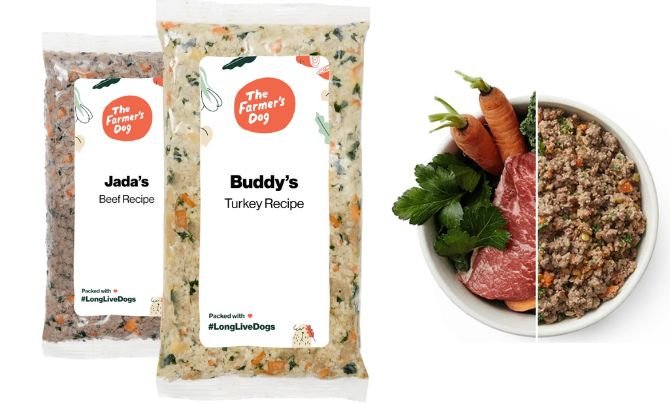
🔄Updating the link, please wait!
Overview: Pre-Portioned Fresh Human-Grade Dog Food
The Farmer’s Dog (TFD) nails the big three most families care about—true Human-Grade Dog Food production, AAFCO complete & balanced recipes, and pre-portioned packs tuned to your dog’s calories. You answer a short quiz (age, weight, body condition, activity), pick your recipes, and get labeled pouches that make dosing effortless—no more accidental over-scooping. Ingredient lists are short and specific (named meats/organs, veggies, healthy fats). Meals smell and look like real food, and the soft, chunky texture wins with picky adults and senior dogs.
Why It Stands Out: Convenience, Completeness & Consistency
TFD’s big advantage is calorie accuracy + kitchen clarity. Each pouch is calibrated to your dog’s target intake, helping prevent slow weight creep after switching from kibble. Their education and FAQs explain what “human-grade” means, and they state complete & balanced suitability for daily feeding (not just topping). Delivery is flexible (nice for small freezers), support is responsive, and texture can be tweaked—lightly warm and mash for dogs who prefer a smoother bite. If budget is tight, run TFD at 50% of the bowl and keep a quality base; you’ll still bank most of the palatability and digestibility perks.
What Makes It Truly “Human-Grade” (Whole-Product Standard)
Unlike fuzzy “made with human-grade ingredients” claims, TFD aligns with the whole-product standard for Human-Grade Dog Food: human-edible inputs and production in human-food facilities with documented handling, storage, and transport controls. Labels are clean, and adequacy statements are explicit. That means less detective work for you: you’re not guessing about factory standards or whether the claim only covers a single ingredient. Pair that with pre-portioned packaging and you get both the safety/quality story and day-to-day practicality.
Best For
- First-time fresh feeders who want plug-and-play Human-Grade Dog Food
- Picky eaters and olders who like soft, aromatic meals
- Weight-management plans that need precise calories
- Families aiming for partial-fresh (25–50%) to balance cost and benefits
Pricing Snapshot
Personalized by weight, activity, and recipe; larger dogs and richer proteins (e.g., beef) price higher. Expect intro promos and autoship savings. Partial-fresh strategies (25–50%) cut cost while preserving most benefits. Always confirm current quotes for your dog’s profile.
Pros & Cons
| Pros | Cons |
|---|---|
| ✔️ True whole-product Human-Grade Dog Food; cooked in human-food facilities | ❌ Cost scales with dog size and protein choice (beef often higher) |
| ✔️ AAFCO complete & balanced; clear adequacy statements | ❌ Chunkier texture may not suit all dogs without light warming/mashing |
| ✔️ Pre-portioned packs improve calorie accuracy and weight control | ❌ Requires freezer/fridge space; no true pantry-only alternative |
| ✔️ Flexible deliveries; strong customer support and easy onboarding | ❌ Shipping/cold-chain adds storage planning for small freezers |
Quick Serving & Storage Tips
- Warm, don’t cook: Empty portion into a bowl and gently warm (never microwave sealed pouches).
- Mash for mouthfeel: Fork-mash to a finer texture for small breeds or senior dogs.
- FIFO storage: Keep 2–3 days’ worth in the fridge; freeze the rest and rotate first-in, first-out.
- Hybrid bowls: Try 50/50 with a quality base to manage cost while keeping your dog excited to eat.
2. JustFoodForDogs PantryFresh — Chicken & White Rice (12.5 oz, Pack of 12)

➡️ Check Latest Price on Amazon
Overview: Shelf-Stable Human-Grade Dog Food, Ready When You Are
This PantryFresh recipe delivers Human-Grade Dog Food in a shelf-stable 12.5-oz carton—no freezer required. It’s marketed as a complete meal or topper, so you can feed it solo or mix it into a base diet to boost palatability and moisture. The Chicken & White Rice formula keeps ingredients simple and gentle, making it a popular “settle the stomach” choice while still meeting everyday nutrition needs.
Why It Stands Out: Vet-Formulated, Travel-Friendly, Complete or Topper
Unlike many wet foods that read like chemistry sets, PantryFresh lists recognizable ingredients and is formulated by veterinary nutritionists to be complete & balanced for everyday use. The Tetra Pak–style carton travels well (camping, hotels, sitters) and opens neatly—great when you don’t want to manage thaw-and-portion logistics. As a topper, it supercharges aroma and texture; as a full meal, it simplifies feeding for small to medium dogs or short trips for big pups.
What Makes It Human-Grade (Whole-Product Focus)
The PantryFresh line is positioned as human-grade end-to-end: human-edible ingredients cooked in human-food kitchens under documented safety controls. That means the claim isn’t just about “human-grade ingredients”—it’s about the entire product (ingredient chain, facility standards, and handling) aligning with human-food practices. Pair that with a visible AAFCO adequacy statement on the carton, and you have a pantry-ready option that still fits a Human-Grade Dog Food standard.
Best For
- Families needing pantry convenience without giving up human-grade standards
- Picky eaters who respond to warm, broth-y textures
- Sensitive GI dogs that tend to do well on chicken + rice simplicity
- Travelers, pet sitters, and small-freezer homes
Feeding & Storage Tips (PantryFresh Boxes)
- Serve at room temp or lightly warmed (never microwave sealed cartons).
- Once opened, refrigerate and use within 3–4 days; portion by grams for accuracy.
- As a topper, start at 25–30% of the bowl; for full meals, use the package feeding guide as your baseline, then adjust calories by body condition (ribs palpable, defined waist).
Pricing & Value Snapshot
Buying the 12-pack often reduces per-carton cost versus singles. Value is strongest for small/medium dogs, for travel weeks when freezer space is scarce, or as a long-term topper strategy to keep costs manageable while upgrading ingredient quality and texture.
Pros & Cons
| Pros | Cons |
|---|---|
| ✔️ Shelf-stable Human-Grade Dog Food; perfect for travel and small freezers | ❌ Cost per calorie is higher than bulk kibble, especially for large dogs |
| ✔️ Vet-formulated; marketed as complete & balanced or topper | ❌ Cartons need refrigeration after opening and a 3–4 day use window |
| ✔️ Simple, gentle ingredients (chicken + rice) many sensitive dogs tolerate | ❌ Less protein-dense than some high-meat fresh/frozen options |
| ✔️ Easy portioning; clean ingredient panel and human-food style process | ❌ Not ideal for owners seeking raw or ultra-high-protein formulas |
How to Use It (Topper or Full Meal)
- Topper plan: Mix ¼ to ½ carton into your dog’s base food (adjust total calories). Warm slightly to bloom aroma; fold in thoroughly so each bite is consistent.
- Full meal plan: Follow the feeding chart on the carton, then fine-tune by weekly weigh-ins and stool quality. Active dogs may need modest calorie bumps.
Quick Compare: PantryFresh vs. Frozen Fresh
- PantryFresh: Zero thaw time, easy travel, slightly higher cost per kcal than bulk frozen, great as topper or short-trip full meals.
- Frozen Fresh: Usually better value per kcal and recipe variety, but needs freezer space and thaw planning.
3. Health Extension Gently Cooked Beef & Potato — Bowl-Ready Human-Grade (9 oz, Case of 10)

➡️ Check Latest Price on Amazon
Overview: Pantry-Easy, Bone-Broth–Cooked Human-Grade Dog Food
This Bowl-Ready pouch delivers gently cooked beef, potato, and “superfood” add-ins (e.g., coconut oil, turmeric, goji) simmered in beef bone broth for aroma and moisture. It’s positioned as complete & balanced for all life stages (including large-breed growth) and lists ~383 kcal per 9-oz pouch, making portion math straightforward for toppers or full meals.
Why It Stands Out: All-Life-Stages, No Freezer Needed
Unlike many fresh foods, these pouches are marketed as no refrigeration or freezing required before opening—handy for travel, sitters, or folks with tiny freezers. The line also emphasizes human-grade positioning and recognizable ingredients, aligning with shoppers who want real-food labels without thawing logistics.
Human-Grade Details & Nutrition Receipts
Health Extension’s Gently Cooked page calls the line human-grade and “cooked in bone broth,” while the Beef & Potato product page prints the AAFCO adequacy note for all life stages, including growth of large-size dogs (70 lb+ as adults)—the specific life-stage “receipt” you want to see.
Best For
- Travelers and small-freezer homes wanting Human-Grade Dog Food without thawing
- Picky eaters that respond to warm, broth-y textures
- Puppies and large-breed pups (verify feeding guide; labeled all life stages including large-breed growth)
- Owners building a topper strategy to upgrade aroma and moisture
Feeding & Storage Tips
Serve room-temp or lightly warmed (never heat sealed pouches). For toppers, start around 25–30% of the bowl and adjust total calories; for full meals, use the package guide and the 383 kcal/9-oz reference. Refrigerate after opening and use within a few days per label guidance.
Pros & Cons
| Pros | Cons |
|---|---|
| ✔️ Pantry-ready, bowl-ready format—no thawing; travel-friendly | ❌ Higher cost per kcal than bulk kibble or some frozen fresh |
| ✔️ Positioned as Human-Grade Dog Food; cooked in bone broth with superfoods | ❌ Protein level (10% min as-fed) is moderate vs. ultra high-meat diets |
| ✔️ Labeled all life stages including large-breed growth; ~383 kcal per 9-oz pouch | ❌ Flavor/texture may be rich for very sensitive GI—transition gradually |
| ✔️ Recognizable ingredients; convenient pouches for toppers or full meals | ❌ After opening, refrigeration needed and use-window is limited |
Quick Compare (Use-Case Fit)
- Topper plan: ¼–½ pouch mixed into base diet = big aroma/moisture bump with cost control.
- Full-meal plan: Most practical for small/medium dogs or on-the-go feeding; price larger cases for value.
- Pantry vs. frozen: Pantry ease wins for travel; frozen fresh often wins on cost per kcal.
4. The Honest Kitchen — Human Grade Dehydrated Whole Grain Turkey (10 lb, Makes ~40 lb)
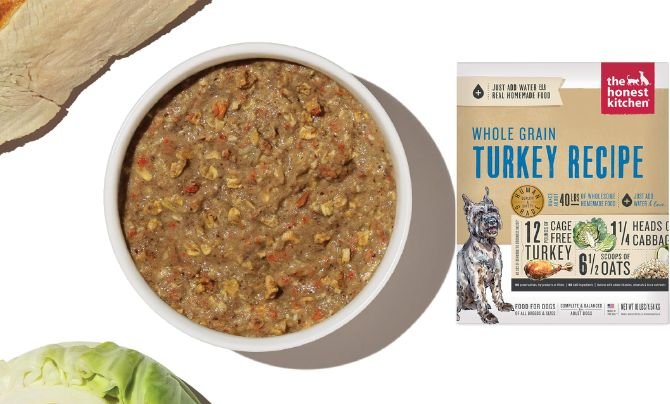
➡️ Check Latest Price on Amazon
Overview: Add-Water Convenience with Human-Grade Dog Food Standards
This dehydrated, whole-grain turkey recipe is designed as a complete meal or topper. The 10-lb box rehydrates to about 40 lb of food, so you get pantry storage, light shipping, and four times the bowl volume once you add warm water. It’s a smart fit if you want Human-Grade Dog Food benefits—recognizable ingredients and kitchen-level controls—without taking over your freezer.
Why It Stands Out: Shelf-Stable, Travel-Ready, Budget-Savvy
Dehydrated meals shine where fresh pouches struggle: no thawing, lighter storage, and easy travel. You control texture—soupy for seniors/picky eaters or thicker for crunch fans—by adjusting water. Cost per rehydrated pound is often friendlier than many fresh/frozen options, while still offering the ingredient clarity that human-grade shoppers expect.
Human-Grade Details (Whole-Product Mindset)
The Honest Kitchen builds its brand around human-grade production—ingredients you can read, prepared in human-food facilities—and positions this recipe as a complete meal (or topper) when served per the feeding guide. Always double-check the AAFCO nutritional adequacy statement on your box to confirm life-stage fit for your dog.
Best For
- Families wanting pantry-friendly Human-Grade Dog Food
- Travelers and small-freezer homes
- Picky eaters (texture/aroma adjustable after rehydration)
- Owners mixing topper + base to balance budget and benefits
Preparation & Feeding Tips
- Measure the dry flakes, add warm water, stir, and let hydrate 3–5 minutes.
- Start with a 1:1–1:1.5 water-to-food feel; tweak for your dog’s texture preference.
- For toppers, begin at 25–30% of the bowl and adjust total daily calories.
- Refrigerate leftovers; use within the window printed on the label.
Pros & Cons
| Pros | Cons |
|---|---|
| ✔️ Pantry-ready, lightweight; ideal for travel and small freezers | ❌ Requires rehydration/rest time before serving |
| ✔️ Human-grade production with recognizable ingredients | ❌ Texture may not suit dogs that insist on wet, stew-like fresh food |
| ✔️ Complete meal or topper; flexible texture (thin or thick) | ❌ Per-calorie cost can exceed commodity kibble |
| ✔️ 10-lb box makes ~40 lb rehydrated—good value per serving | ❌ Must verify AAFCO life-stage statement on your specific box |
How to Use It (Topper vs. Full Meal)
- Topper plan: Mix rehydrated turkey recipe into your base food at ¼–½ bowl to boost aroma and moisture.
- Full meal plan: Follow the box feeding guide, then fine-tune by weekly weigh-ins and body-condition checks (ribs palpable, visible waist).
5. Dr. Harvey’s Specialty Diet Limited Ingredient — Salmon Recipe (5 lb)
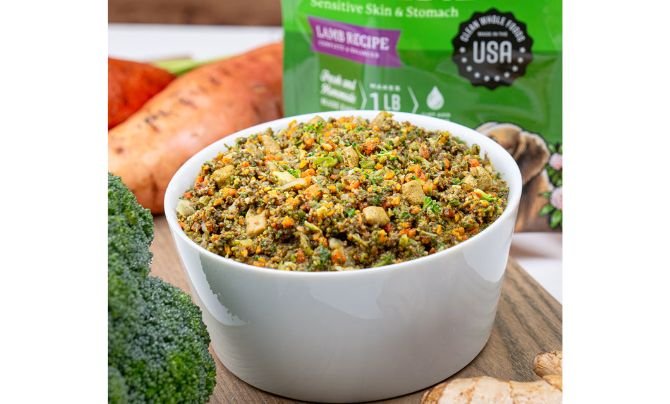
➡️ Check Latest Price on Amazon
Overview: Limited-Ingredient, Pantry-Friendly Human-Grade Dog Food
This Limited Ingredient Salmon Recipe is positioned as Human-Grade Dog Food for pups with skin, stomach, and environmental sensitivities. It’s a dehydrated formula—store it in the pantry, then just add warm water to serve as a complete meal or a super-palatable topper. The emphasis is on real salmon as the lead protein with a short, readable ingredient list designed to reduce variables for sensitive dogs. Several retailers highlight the “just add water” prep and made/dehydrated in the USA positioning, which makes it appealing if you want human-grade standards without freezer logistics.
Why It Stands Out: Single-Protein Simplicity + “Just Add Water” Ease
For dogs that do best on simpler recipes, a salmon-forward, grain-free LID can be a smart starting point. Compared with frozen fresh, dehydrated formats cut shipping weight and space needs while still delivering recognizable ingredients. Many listings for this diet specifically call out human-grade positioning and sensitivities support, so it’s a natural option for rotation plans or as a long-term fish-based primary diet—provided you confirm the AAFCO adequacy statement on your bag for your dog’s life stage. (Some product pages and brand materials describe the line as designed for sensitive dogs; always verify the exact adequacy statement printed on your specific package.)
Human-Grade & LID Details (What to Check)
- Human-grade positioning: Look for language indicating human-food–style kitchens/processes, not just “human-grade ingredients.”
- LID design: Salmon as the primary protein with minimal extras helps elimination trials.
- Preparation: Add water and allow a few minutes for full hydration before serving.
- Label proof: Confirm the AAFCO statement (life stage, formulated vs. feeding trials) on the physical bag or the brand’s spec sheet.
Retailer and brand pages reinforce the human-grade and limited-ingredient framing and note easy hydration and US production.
Best For
- Dogs with sensitivities that do better on a single animal protein (salmon)
- Owners who need pantry-friendly convenience (travel, sitters, small freezers)
- Pet parents building a topper strategy to upgrade moisture/aroma without going 100% fresh
- Households that prefer add-water meals and clear, short ingredient panels
Feeding & Preparation Tips
- Start with a 1:1 to 1:1.5 (food:water by volume) ratio; adjust thickness to taste.
- Let it sit 3–5 minutes so flakes fully hydrate and starches bloom.
- Introduce over 10 days (gradual mix with current food) for GI comfort.
- Portion by grams (kitchen scale) and adjust weekly based on body condition and stool quality.
- Store dry product in a cool, dry place; refrigerate rehydrated leftovers and use within the label’s window.
Pros & Cons
| Pros | Cons |
|---|---|
| ✔️ Human-Grade Dog Food positioning; limited-ingredient, salmon-first design | ❌ Per-calorie cost higher than commodity kibble; price varies by retailer |
| ✔️ Pantry-friendly dehydrated format; just add water—great for travel/sitters | ❌ Requires rehydration/rest time; some dogs prefer wet/fresh textures |
| ✔️ Single-protein clarity can help with sensitivities and elimination trials | ❌ Verify the exact AAFCO life-stage statement on your bag before full-time feeding |
| ✔️ Made/dehydrated in the USA (as listed by retailers) | ❌ Fish-forward aroma may not suit every household; transition slowly for GI-sensitive pups |
Quick Compare (Use-Case Fit)
- Vs. frozen fresh: Less freezer hassle and travel-friendlier; fresh may offer different textures and sometimes sharper value per kcal in bulk.
- Vs. other dehydrated human-grade: Similar ease; choose between salmon vs. poultry/carb profiles based on your dog’s tolerance and your budget.
- As a topper: Start at 25–30% of the bowl to boost palatability/moisture while keeping costs predictable.
6. Ollie — Best Value Fresh with a Standout Food-Safety Program
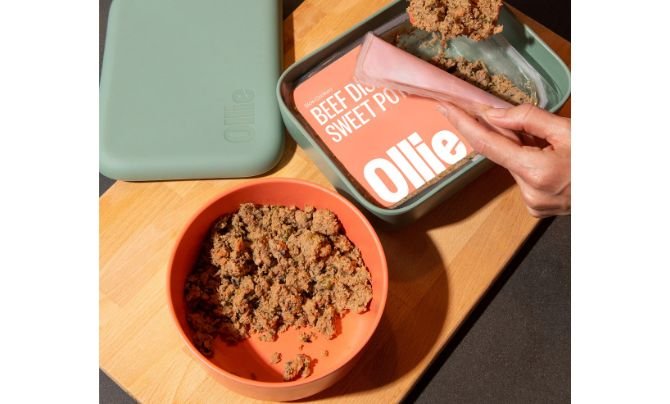
🔄Updating the link, please wait!
Overview: Fresh, Pre-Portioned Human-Grade Dog Food
Ollie delivers gently cooked, Human-Grade Dog Food in freezer-friendly packs you portion by weight. The meals are soft, aromatic, and easy to serve as a full diet or a topper. For first-time fresh feeders, Ollie’s quiz, starter box, and clear feeding directions make onboarding simple—especially for small and medium dogs where portion sizes are compact and costs stay approachable.
Why It Stands Out: Pricing Confidence + Safety Receipts
Ollie pairs friendly pricing and frequent intro offers with unusually clear food-safety language for a DTC fresh brand. The company states that meals are cooked in human-grade kitchens, designed or approved by veterinary nutritionists, and labeled to AAFCO standards for complete nutrition. In the bowl, that translates to predictable palatability and straightforward portion control; on paper, it gives budget-minded owners more confidence that value isn’t coming at the expense of process.
USDA Process Verified Kitchens, AAFCO Compliance & What That Means for You
Marketing words are cheap; audits aren’t. Ollie’s safety pages cite FDA and USDA standards for human-grade manufacturing and reference USDA Process Verified programs—signals of documented preventive controls, sanitation, supplier verification, and traceability aligned with a whole-product interpretation of Human-Grade Dog Food. Layer in AAFCO compliance and vet-nutritionist oversight, and you get repeatable quality, practical packaging, and clear feeding guidance you (and your vet) can follow.
Best For
- Owners who want human-grade fresh food with plain-English safety documentation
- First-timers leveraging intro discounts and an easy plan builder
- Dogs that benefit from soft textures, measured portions, and gentle recipes
- Households planning partial fresh (25–50%) to balance results and budget
Pricing Snapshot
Personalized by weight, recipe, and delivery cadence. Intro deals meaningfully lower month one; poultry recipes (chicken/turkey) typically price lower than beef or novel proteins. For large/giant breeds, consider topper or 50/50 hybrid bowls to control monthly spend without losing the palatability boost of Human-Grade Dog Food.
Feeding & Storage Tips
- Thaw in the fridge, then portion by grams for accuracy.
- Serve room-temp to lightly warm (never microwave sealed packs).
- Keep a 3–4 day fridge window once opened; rotate stock FIFO (first in, first out).
- For toppers, start at 25–30% of the bowl; blend thoroughly so every bite is consistent.
Pros & Cons
| Pros | Cons |
|---|---|
| ✔️ Cites USDA Process Verified programs; FDA/USDA human-grade manufacturing frameworks | ❌ Cold-chain storage needed; not pantry-only |
| ✔️ AAFCO complete recipes; vet-nutritionist involvement | ❌ Cost scales with dog size and richer proteins (e.g., beef) |
| ✔️ Approachable pricing with frequent intro promos; strong value among fresh brands | ❌ Some dogs prefer chunkier textures—often solved by light warming/mashing |
| ✔️ Simple onboarding (quiz, starter box) and clear feeding guidance | ❌ Limited shelf-stable options if you need 100% pantry storage |
Quick Compare (Use-Case Fit)
- Budget tip: Run 50/50 (fresh + quality kibble) or use Ollie as a 25–30% topper to capture palatability and stool quality gains while keeping monthly costs steady.
- Vs. other fresh human-grade: Ollie emphasizes safety receipts and promos, making it a low-friction entry to fresh feeding.
- Vs. dehydrated/air-dried: Fresh wins on aroma/texture; dehydrated wins on pantry convenience and travel.
7. Spot & Tango (UnKibble + Fresh) — Best Human-Grade “Dry” Alternative
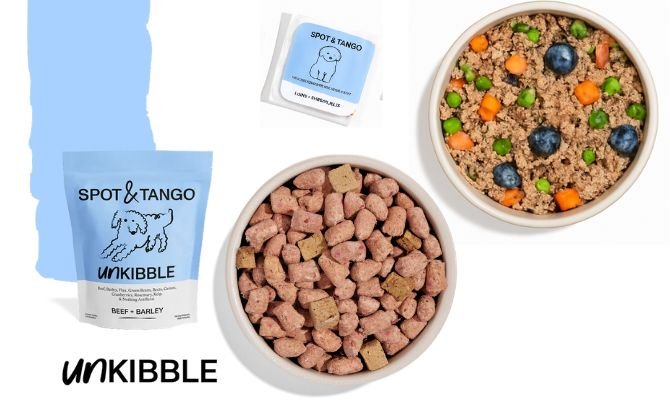
🔄Updating the link, please wait!
Overview: Scoop-and-Serve Convenience Meets Human-Grade Dog Food
If you love the convenience of scooping but want ingredients closer to real, lightly cooked meals, Spot & Tango bridges the gap. The brand offers two lines:
- Fresh — gently cooked, human-grade meals with soft, stew-like texture.
- UnKibble — a dry, scoop-and-serve food made with human-grade ingredients and low-and-slow drying (not high-heat extrusion).
Both lines are formulated to meet AAFCO nutrient profiles for daily feeding, so you can feed them as full diets or mix them in flexible ways.
Why It Stands Out for Human-Grade Dog Food Shoppers
- Real-food ingredient lists and an emphasis on human-grade ingredients.
- All-life-stage coverage on select recipes (always verify your specific recipe’s AAFCO statement).
- Two compatible formats make it easy to tailor texture, storage, and cost to your household.
UnKibble vs. Fresh: Which Path Fits Your Dog?
- Fresh (gently cooked): The flavor bomb—moist, aromatic, and great for picky eaters, olders, and dogs that benefit from softer textures.
- UnKibble (dry fresh): The weekday hero—shelf-stable, tidy, scoopable, and sitter/travel friendly. Recipes typically start with USDA meat and are fortified to AAFCO targets.
Pro tip: Build a hybrid bowl—½ UnKibble + ½ Fresh—then adjust to your dog’s total daily calories. You’ll keep convenience and texture interest while smoothing GI transitions.
Best For
- Families craving scoop-and-serve ease without giving up Human-Grade Dog Food ingredient standards
- Travelers, sitters, and multi-dog homes
- Puppies needing all-life-stage coverage (verify per recipe)
- Owners planning hybrid bowls to balance budget, aroma, and stool quality
Pricing Snapshot
- UnKibble: Typically less per day than Fresh for most sizes; wins on pantry convenience.
- Fresh: Priced in line with other gently cooked human-grade brands; wins on aroma and palatability.
- Watch for promotions and subscribe-and-save to lower monthly cost, and choose poultry first if you’re budget-sensitive.
Feeding & Storage Tips
- UnKibble: Store in a cool, dry place. For gulpers/seniors, add a splash of warm water to boost aroma and slow eating.
- Fresh: Keep frozen, thaw in the fridge, and serve room-temp to lightly warm (never microwave sealed packs).
- Hybrid bowls: Start at 50/50 or 25–30% Fresh as a topper; blend thoroughly and track total daily calories.
Pros & Cons
| Pros | Cons |
|---|---|
| ✔️ UnKibble = dry convenience with human-grade ingredients; Fresh for aroma/texture | ❌ Site language centers on “human-grade ingredients”; verify whole-product human-grade details if that matters to you |
| ✔️ Recipes formulated to meet AAFCO for daily feeding; select options note large-breed growth | ❌ Lower moisture than fresh (for UnKibble); add warm water for gulpers or senior dogs |
| ✔️ Easy to build hybrid bowls (½ UnKibble + ½ Fresh) for cost control and GI comfort | ❌ Premium pricing vs. commodity kibble; rely on promos/subscribe-and-save |
| ✔️ Scoop-and-serve storage and travel simplicity; sitter-friendly | ❌ Fresh line requires freezer/fridge space and thaw planning |
Quick Compare (Use-Case Fit)
- Want the best of both? Run hybrid—you’ll keep convenience, lift palatability, and maintain complete nutrition under the Human-Grade Dog Food umbrella.
- Need zero thaw & fast scoops? Choose UnKibble.
- Have a picky eater or dental wear? Choose Fresh (warm lightly).
8. Open Farm Rustic Stews — Grass-Fed Beef (12.5 oz, Case of 12)
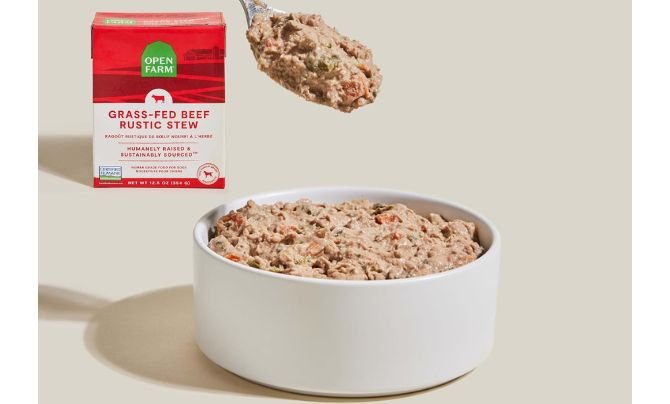
➡️ Check Latest Price on Amazon
Overview: Pantry-Friendly Human-Grade Dog Food with Bone Broth
Open Farm’s Rustic Stews give you wet, kettle-cooked meals made with human-grade ingredients, designed to be fed as a complete & balanced diet or as a topper. The Grass-Fed Beef recipe comes in 12.5-oz packs (case of 12) and leans on humanely raised, grass-fed beef, veggies, and bone broth for aroma and moisture—great for picky eaters and travel weeks.
Why It Stands Out
- Complete or topper: Labeled to serve on its own or to boost a base food.
- Ingredient ethos: Humanely raised proteins, non-GMO veggies, and human-grade inputs.
- Grain- & potato-free: For owners avoiding those carbs; see the recipe page for full formula.
Packaging & Convenience (Tetra Pak)
Rustic Stews come in BPA-free, resealable Tetra Pak cartons—lighter to ship, easy to store, and simple to pour. That’s a practical upgrade over cans when you’re feeding over a couple of days.
Best For
- Families wanting pantry-ready Human-Grade Dog Food without thawing
- Picky eaters who respond to warm, broth-y textures
- Travelers/sitters; multi-dog homes rotating toppers for variety
Feeding & Storage Tips
- As a meal: Typical guidance is about 1 pack per ~12 lb bodyweight/day (check your carton’s chart).
- As a topper: Reduce base kibble when adding a full pack (brand guidance often notes “reduce by ~⅔ cup per pack”).
- After opening: Refrigerate; use within 3 days. Warm gently (never in a sealed carton) to bloom aroma.
Pros & Cons
| Pros | Cons |
|---|---|
| ✔️ Complete & balanced Human-Grade Dog Food or topper—flexible use | ❌ Higher cost per kcal than bulk kibble or some frozen fresh |
| ✔️ Humanely raised, grass-fed beef; non-GMO veggies; grain & potato free | ❌ Wet format needs fridge after opening; 3-day use window |
| ✔️ BPA-free, resealable Tetra Pak; travel-friendly and easy to pour | ❌ Some dogs may need a slow transition due to richer stew texture |
| ✔️ Bone-broth base boosts aroma and palatability | ❌ Price varies by retailer; large dogs may find full-meal costs add up |
Quick Compare (Use-Case Fit)
- Pantry vs. frozen fresh: Rustic Stews win on storage and travel; frozen fresh can win on cost per kcal in bulk.
- Topper strategy: Mix ¼–½ pack into a base diet for moisture + flavor; remember to adjust total calories.
- Rotation: Rotate among Rustic Stew flavors for variety while staying in a similar texture/format.
9. Northwest Naturals Freeze-Dried Lamb — Bite-Size Nuggets (25 oz)
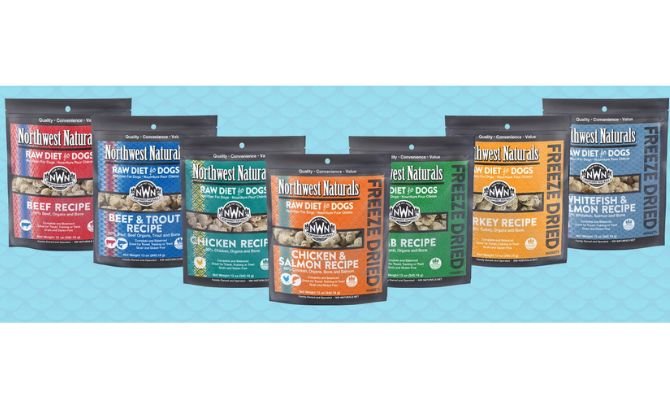
➡️ Check Latest Price on Amazon
Overview: Freeze-Dried Raw, Human-Grade Dog Food in Scoopable Nuggets
Northwest Naturals’ Lamb Nuggets deliver a freeze-dried raw take on Human-Grade Dog Food: single-animal protein (lamb), limited ingredients, and grain-free, pressed into bite-size nuggets you can scoop, crumble, or serve whole. Because moisture is removed at low temperatures, these nuggets keep pantry-stable while preserving aroma and nutrient density—great for picky eaters, training rewards, travel, and as a full raw meal if the label confirms complete & balanced status for your dog’s life stage.
Why It Stands Out (vs. Typical Kibble or Canned)
- Raw nutrition, minus the freezer: Freeze-drying offers raw’s high-meat profile without thawing or mess.
- Single-protein clarity: Lamb-only animal protein helps with elimination diets or sensitivities.
- Flexible format: Feed as-is, rehydrate into a soft meal, or crumble as a high-value topper.
- Portionable & portable: Lightweight, resealable pouch = easy storage, hiking, boarding, or sitter handoffs.
Human-Grade Details & Label Must-Checks
This product is positioned as human-grade ingredients with a raw, freeze-dried process. Because raw and freeze-dried diets vary by recipe, do a 60-second label audit before full-time feeding:
- AAFCO statement: Confirm “complete & balanced” for your dog’s life stage (growth/maintenance/ALS). Some raw/freeze-dried items are supplemental only—perfect toppers but not sole diets.
- Feeding method: Follow weight-based guides and any rehydration directions.
- Handling: Treat as raw—wash hands, clean surfaces/bowls, store sealed and dry.
Best For
- Dogs that thrive on high-protein, meat-forward diets
- Sensitive pups needing limited-ingredient or single-animal protein (lamb)
- Picky eaters and training (nuggets double as irresistible rewards)
- Households wanting pantry-ready raw without freezer management
Feeding & Storage Tips (Freeze-Dried Raw)
- As-is or rehydrated: Serve dry for crunch or add warm water/bone broth (1–2 Tbsp per meal, adjust to preferred texture).
- Topper mode: Crumble ¼–½ cup over a base food to lift aroma/palatability; subtract base calories accordingly.
- Transition: 7–10 days, increasing nuggets while monitoring stools/skin/energy.
- Storage: Keep cool, dry, sealed. After rehydration, discard leftovers within a few hours.
- Safety: Handle like raw—wash hands/utensils; keep away from young children or immunocompromised persons during prep.
Pros & Cons
| Pros | Cons |
|---|---|
| ✔️ Freeze-dried **raw** with human-grade, limited ingredients; single-protein lamb | ❌ **Premium price** per kcal vs. kibble; consider topper use to manage cost |
| ✔️ **Pantry-stable**; no thawing—great for travel, training, and sitters | ❌ Requires **raw-handling hygiene** (wash hands, clean surfaces/bowls) |
| ✔️ **Bite-size nuggets**: serve whole, crumble, or rehydrate to soft texture | ❌ Some dogs need a **gradual transition** to rich, high-meat formulas |
| ✔️ **Grain-free** and **high-protein** profile for meat-lovers and picky eaters | ❌ Verify the **AAFCO adequacy statement**—some freeze-dried raws are topper-only |
Quick Compare (Use-Case Fit)
- Vs. fresh human-grade: Freeze-dried wins on portability and shelf life; fresh wins on moisture and often cost per kcal in bulk.
- Vs. air-dried/dehydrated: Nuggets are softer and rehydrate faster; air-dried tends to be denser and more “jerky-like.”
- Budget tip: Use as a 25–50% topper to capture raw palatability and stool quality benefits while keeping monthly spend predictable.
10. PetPlate — Best for Picky Eaters & Recipe Diversity
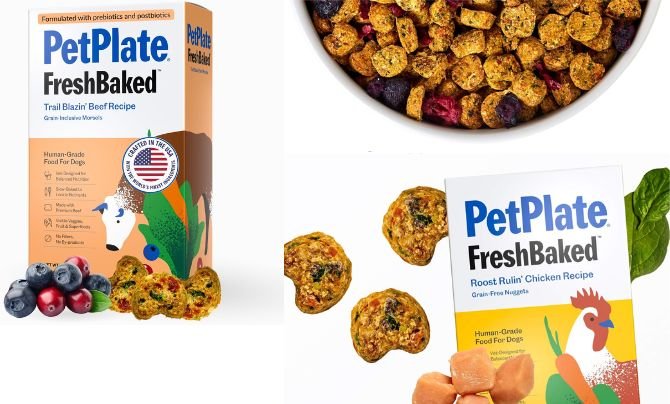
➡️ Check Latest Price on Amazon: Beef & Chicken
Overview: Pre-Portioned, Aroma-Forward Human-Grade Dog Food
PetPlate serves up 100% Human-Grade Dog Food that’s vet-designed, AAFCO complete, and cooked in small batches under USDA processes, then frozen for doorstep delivery. Meals arrive in neat, pre-portioned containers that warm quickly and smell like dinner—great news for picky pups and senior dogs who do best with soft, stew-like textures. With multiple proteins (beef, chicken, turkey, lamb, and more), it’s easy to find a favorite without guesswork.
Why It Stands Out for Picky Eaters
Many “meh” eaters flip to “clean-bowl club” when the food is gently warmed and the broth/fats bloom. PetPlate leans into that: soft, fragrant, stew-like recipes that mix smoothly with toppers or base foods. The plan builder handles calories, so you’re not eyeballing portions, and the cadence of shipments is predictable—simple to maintain once you dial in the right box size.
Human-Grade Meats & Veggies to AAFCO Standards
On paper, PetPlate reads like a vet checklist; in the bowl, it eats like real food. The brand’s core language hits all the structural signals: “100% human-grade,” USDA small-batch preparation, and designed by a veterinary nutritionist to meet AAFCO standards for everyday feeding. That clarity means you can feed full-time or run 50/50 with a high-quality base and stay complete & balanced either way.
Best For
- Picky or senior dogs that respond to soft, savory textures
- Owners who want vet-designed, AAFCO-complete meals with a simple safety story
- Families that prefer frozen fresh convenience with minimal prep
- Households planning partial fresh (topper or 50/50) to manage monthly spend
Pricing Snapshot
Pricing varies by dog size, recipe, and delivery cadence; intro deals are common. Budget tips: start with chicken/turkey proteins, choose a longer delivery interval if freezer space allows, or use PetPlate as a 25–50% topper to capture palatability and stool-quality gains while keeping costs predictable.
Feeding & Storage Tips
- Thaw in the fridge; serve room-temp to lightly warm (never microwave sealed containers).
- Portion by grams for accuracy; recheck calories after 1–2 weeks by weight/BCS.
- Refrigerate opened portions and use within 3–4 days; freeze the rest and rotate FIFO.
- For toppers, start at 25–30% of the bowl; blend thoroughly so each bite is consistent.
Pros & Cons
| Pros | Cons |
|---|---|
| ✔️ 100% Human-Grade Dog Food; vet-designed; AAFCO complete; USDA small-batch framing | ❌ Requires freezer/fridge space; cold-chain logistics vs. pantry foods |
| ✔️ Soft, stew-like textures and strong aroma—excellent for picky eaters & senior dogs | ❌ Per-day cost rises with dog size and richer proteins |
| ✔️ Pre-portioned packs simplify calorie control and weight management | ❌ Some recipes may be richer than kibble—use the brand’s calorie guide to avoid overfeeding |
| ✔️ Clear onboarding, predictable shipping, and broad recipe variety | ❌ If you need strictly pantry-ready, consider a dehydrated/air-dried human-grade option for trips |
Quick Compare (Use-Case Fit)
- Vs. dehydrated/air-dried: PetPlate wins on aroma/texture; dehydrated wins on pantry travel and no-thaw convenience.
- Vs. other fresh human-grade: PetPlate leans hardest into picky-eater palatability and pre-portioned simplicity.
- Budget move: Run a 50/50 hybrid (PetPlate + quality kibble) or 25–30% topper to stretch value while keeping bowls exciting.
Runners-Up & Newcomers to Watch in 2026
Full Moon NAE Freshly Crafted — Homestead Turkey (Frozen Fresh, 64 oz, Pack of 3)
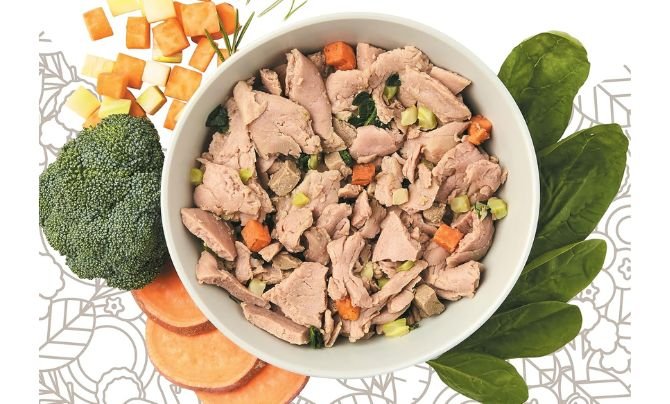
🔗 Check Latest Price on Amazon
Overview: Freezer-Ready Human-Grade Dog Food
A frozen fresh option positioned with “NAE” in the name and a homestead turkey recipe. It aims to deliver Human-Grade Dog Food convenience at scale—cook-style texture, straightforward ingredients, freezer storage, and easy thaw-and-serve portions. Always confirm the AAFCO adequacy statement and life-stage fit on your specific bag.
Why It Stands Out
- Frozen fresh format for aroma and texture picky dogs love
- Large multi-pack for better value-per-meal than single pouches
- Turkey-first profile: a common “gentle” protein many dogs tolerate
Best For
Travel back-stockers, small-to-medium dogs, and families that want human-grade freshness without a subscription.
Feeding & Storage Tips
Thaw in the refrigerator, portion by grams, and use thawed meals within the label window. Never microwave sealed packaging.
Pros & Cons
| Pros | Cons |
|---|---|
| ✔️ Frozen fresh texture and aroma; easy clean-bowl appeal | ❌ Needs freezer space and thaw planning |
| ✔️ Turkey-focused recipe many sensitive dogs accept | ❌ Per-day cost can rise for large/giant breeds |
| ✔️ Multi-pack improves value vs. singles | ❌ Verify AAFCO life-stage statement before full-time feeding |
| ✔️ Straightforward ingredient panel (check your lot) | ❌ Shipping weight is higher than dehydrated/air-dried |
Sundays (Air-Dried) — Human-Grade “Jerky-Style” Meals
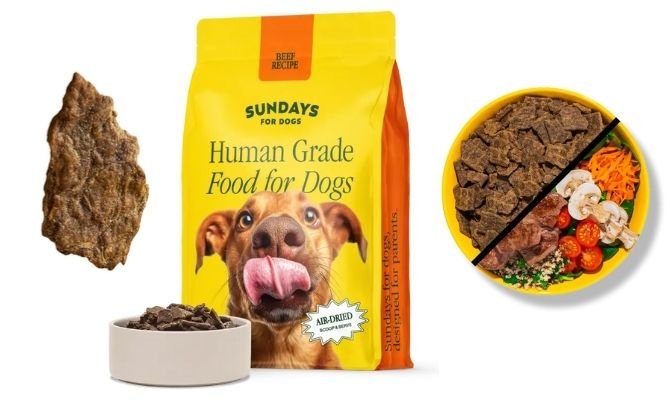
🔄Updating the link, please wait!
Overview: Scoopable, Shelf-Stable Human-Grade Dog Food
Sundays offers air-dried squares—think jerky-like, pantry-ready pieces made with human-grade ingredients and low/slow drying instead of extrusion. It’s built for scoop-and-serve ease with a clean label feel.
Why It Stands Out
- Air-dried format balances convenience with real-food vibes
- Travel-friendly: no thawing, minimal mess
- Typically higher calorie density than fresh—small portions go far
Best For
Busy households, travelers, and dogs who want crunch with quality. Great as a full meal (if AAFCO-complete) or topper.
Feeding & Storage Tips
Store cool and dry. For gulpers or olders, add a splash of warm water to soften and boost aroma. Transition over 7–10 days.
Pros & Cons
| Pros | Cons |
|---|---|
| ✔️ Shelf-stable, scoopable; perfect for sitters & travel | ❌ Lower moisture than fresh; hydration may be helpful |
| ✔️ Human-grade ingredient deck; tidy feeding | ❌ Premium price vs. commodity kibble |
| ✔️ Works as full diet (if AAFCO-complete) or high-value topper | ❌ Verify recipe’s AAFCO statement and calories before full-time use |
| ✔️ Dense calories—smaller portions for small dogs | ❌ Rich for some GI-sensitive pups without a slow transition |
Portland Pet Food Company — Human-Grade Toppers & Meal Pouches
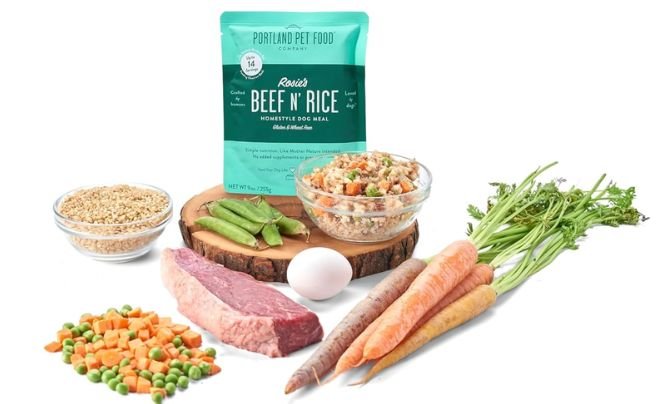
➡️ Check Latest Price on Amazon
Overview: Pantry-Ready Boosters with Real-Food Labels
Portland Pet Food Company (PPFC) makes human-grade pouches often used as toppers (and some as meals). Ingredient lists read like a home recipe and the textures are soft and stew-like, ideal for picky eaters and senior dogs.
Why It Stands Out
- Minimal-ingredient, kitchen-style recipes
- Excellent palatability: warms fast, smells like dinner
- Great appetite jump-start for convalescing or selective dogs
Best For
Owners upgrading aroma and moisture without going 100% fresh; dogs needing a gentle topper to finish meals.
Feeding & Storage Tips
Check whether your pouch is complete & balanced or supplemental (topper-only). Refrigerate after opening; use within the label window. Adjust base calories.
Pros & Cons
| Pros | Cons |
|---|---|
| ✔️ Human-grade, short labels; excellent topper for picky dogs | ❌ Many pouches are supplemental—not full diets |
| ✔️ Pantry-friendly; quick warm-up boosts aroma | ❌ Per-calorie cost is higher than base kibble |
| ✔️ Texture suits senior and sensitive mouths | ❌ Not designed for long-term sole feeding unless labeled complete |
| ✔️ Easy portion control for mix-in strategies | ❌ Needs fridge after opening; short use window |
How to use all three smartly: keep a frozen fresh option (Full Moon) for primary meals, an air-dried bag (Sundays) for scoopable travel or hybrid bowls, and PPFC toppers to jump-start appetite. That trio covers Human-Grade Dog Food quality across freezer, pantry, and picky-eater scenarios—without locking you into a single format.
(a) Top 10 Best Dog Muzzles Reviews
(b) Top 10 Best Pet Hair Broom for Carpets Reviews
(c) Top 10 Best Raised Dog Bed Reviews (Updated Guide & Tips)
(d) Top 10 Best Dog Dryer 2026 – Expert Reviews, Buying Guide
(e) Top 10 Best Dog Bowls for Your Dog at Home & Easy Go to Travel
(f) PetSafe Drinkwell Replacement Foam Filters Review
DIY “Human-Grade” at Home: Safe or Risky?
The Big Idea: Balance Beats “Looks Healthy”
Home-cooked meals can look perfect—fresh chicken, bright carrots, a dash of olive oil—yet still miss critical micronutrients. Dogs need precise amounts of calcium, phosphorus, iodine, copper, zinc, vitamins A/D/E/K/B-complex, plus sulfur amino acids (e.g., taurine/methionine support depending on the formula). Shortfalls don’t scream right away; they whisper as dull coats, low energy, poor stool quality, and over time can snowball into real health problems. The fix isn’t guesswork—it’s validated balancing. If you want the control and kitchen pride of DIY while staying within the standard, treat home cooking like a recipe with math, not a vibe. That’s where brand-supplied nutrient kits and vet-developed formulations make the difference between “home-cooked” and complete Human-Grade Dog Food.
What Makes DIY Human-Grade Dog Food “Complete”
“Complete & balanced” means the finished meal meets AAFCO nutrient profiles for the life stage you intend (maintenance, growth, or all life stages). At home, you can’t eyeball calcium or iodine; you need either:
- A tested recipe (weights, prep method, cook temps) plus
- The exact nutrient blend specified (a branded DIY supplement mix or a formulation from a board-certified veterinary nutritionist).
Many reputable brands sell DIY kits that include: (1) a step-by-step recipe, (2) a shopping list with exact gram weights, and (3) a vitamin–mineral blend calibrated for that recipe. Follow it to the letter and you’ll hit the same completeness bar that commercial Human-Grade Dog Food recipes do. Swap ingredients, change cooking water, or “round” gram weights—and you’ve changed the math.
Step-by-Step: Safe Cook Day Blueprint
- Pick one tested recipe (e.g., turkey + rice or beef + sweet potato) designed for your dog’s life stage.
- Weigh everything raw with a kitchen scale—protein trims, rice, veg, oils—in grams, not cups.
- Cook as directed (bake/simmer/sous-vide). Don’t discard cooking liquids unless the recipe says so; that can remove minerals.
- Cool quickly (sheet pans; ice bath if needed) to move through the “danger zone” fast.
- Stir in the nutrient blend at the specified temperature (often after cooling) so heat-sensitive vitamins survive.
- Portion by weight into labeled containers (date, recipe, calories/gram).
- Freeze most, refrigerate a 2–3 day supply. Rotate FIFO (first in, first out).
- Feed by grams, not scoops. Re-check calories after 2 weeks by looking at weight and body condition.
Cook-Day Math (Simple Example)
- Final batch weight: 2,000 g; total batch calories: 3,600 kcal.
- Calorie density: 3,600 ÷ 2,000 = 1.8 kcal/g.
- Dog’s target: 520 kcal/day → ~289 g/day (split into meals).
Adjust only if weight or body condition drifts; don’t “eyeball up” tasty meals.
Sanitation & Food Safety Non-Negotiables
- Separate raw and cooked zones; sanitize boards/knives between tasks.
- Hand hygiene before/after handling meat and after mixing supplements.
- Chill fast: From stove to shallow containers; refrigerate within 60–90 minutes.
- Fridge life: Most DIY batches last 3–4 days refrigerated; freeze the rest.
- Reheat gently (or serve room temp); never scorch or microwave sealed bags.
- Label everything: Recipe, date, and calories/gram so you—or a sitter—can feed accurately.
Common DIY Mistakes (and Easy Fixes)
- Swapping proteins/starches (“I used salmon instead of turkey”): different fat/iodine/taurine profiles = different math. Fix: stick to the written protein/starch or get a vet-nutritionist reformulation.
- Skipping the supplement blend: instant micronutrient holes. Fix: use the specified blend and dose.
- Measuring by volume: cups for rice vary wildly. Fix: weigh in grams.
- Tossing broth/cooking water when the recipe assumes it’s included. Fix: follow the method exactly.
- Feeding one recipe forever: rotation helps cover natural variability. Fix: keep 2–3 tested recipes in your rotation (introduced one at a time).
When NOT to DIY (or When to Get a Custom Plan)
- Puppies (especially large-breed): narrow calcium/phosphorus windows—errors here matter.
- Pregnant/lactating dogs: energy and micronutrient demands spike.
- Chronic disease (kidney, liver, GI, pancreatitis, stones): requires therapeutic formulations and vet oversight.
- Food allergies needing precise elimination trials.
If you’re in any of these groups, request a board-certified veterinary nutritionist plan or use a brand’s therapeutic recipes as directed by your vet.
Budget & Time Math: Is DIY Cheaper Than Human-Grade Delivery?
- Ingredient control (buying in bulk, choosing chicken/turkey) can lower cost per kcal.
- Time cost matters: shopping, cooking, cooling, portioning, cleanup.
- Supplements add a small, predictable cost—but they’re the guardrails that make DIY safe.
A realistic path for many households is hybrid feeding: 50% DIY (kit-based) + 50% commercial Human-Grade Dog Food. You keep standards high, reduce freezer chaos, and smooth out supply hiccups.
Template: Vet-Ready Log & Recheck Plan
- Starting weight & body condition score (BCS).
- Daily feed grams and calories (note treats—cap at ≤10% of daily kcal).
- Stool log (consistency 1–5) and any GI signs (gas, nausea).
- Skin/coat notes and energy (AM/PM).
- Every 2 weeks: Weigh, review BCS, adjust calories ±5–10% if needed.
- Every 3–6 months: Vet check; consider bloodwork if long-term DIY. Bring the recipe, nutrient kit label, and batch math.
Bottom Line
DIY can absolutely deliver safe, complete Human-Grade Dog Food—if you treat it like cooking with a blueprint. Use tested recipes, the exact nutrient blend, rigorous sanitation, and by-the-gram feeding. Track outcomes, adjust calories (not ingredients), and loop your vet in for life-stage or medical changes. That’s the difference between “home-cooked” and home-cooked done right.
Conclusion: How to Put Human-Grade Dog Food to Work (Every Day, On Any Budget)
Choosing Human-Grade Dog Food isn’t about chasing a buzzword—it’s about matching whole-product human-grade standards (ingredients + kitchens + handling) with a recipe that’s AAFCO complete & balanced for your dog’s life stage. If you remember only three things, make them these:
- Verify the claim — Look for an explicit whole-product human-grade explanation and a clear AAFCO adequacy statement on the exact recipe you’ll feed.
- Fit the format to your life — Fresh/gently cooked for peak palatability, dehydrated/air-dried for pantry convenience, or a hybrid bowl to balance cost and results.
- Transition with discipline — Follow a 10-day ramp, weigh portions, track stools/energy, and adjust calories before you switch formulas.
With that foundation, any pick from the 2026 Top 10 can work: personalized fresh (The Farmer’s Dog), research-forward pantry packs (JustFoodForDogs PantryFresh), bone-broth pouches (Health Extension), add-water dehydrated (The Honest Kitchen, Dr. Harvey’s), value-driven fresh with documented safety (Ollie), scoopable “dry fresh” (Spot & Tango UnKibble), travel-ready stews (Open Farm), freeze-dried raw nuggets (Northwest Naturals), and aroma-first fresh for picky eaters (PetPlate). Start where your dog and your schedule meet, keep notes for two weeks, and let the bowl—and your dog’s body condition—tell you what’s working.
FAQs: Human-Grade Dog Food (Quick Answers)
1) What’s the fastest way to verify a true “Human-Grade” claim?
Scan the product page/label for: (a) a whole-product human-grade explanation (ingredients and human-food facility/handling), and (b) the AAFCO nutritional adequacy line for your dog’s life stage. If support can’t confirm both, keep shopping.
2) Can I rotate between fresh, dehydrated, and air-dried human-grade foods?
Yes—rotation is fine if each recipe is AAFCO complete for your dog’s life stage. Introduce new formats slowly (7–10 days), keep calorie totals steady, and watch stools/energy as you change textures and proteins.
3) Are vitamin/mineral premixes a red flag?
No. Many excellent Human-Grade Dog Food recipes use a premix to meet AAFCO precisely. A few brands balance with whole foods only—that’s fine too—but the priority is documented completeness and consistent quality controls.
4) How do I estimate portions when switching from kibble?
Use the brand’s calorie guide for your dog’s weight, then weigh meals in grams for the first two weeks. Re-check body weight and body condition score weekly; adjust calories ±5–10% before changing recipes.
5) What if full fresh is too pricey for a large dog?
Go partial fresh. Make 25–50% of the bowl human-grade and keep a high-quality base kibble. You’ll capture most palatability/digestibility gains while keeping monthly costs predictable. Pick poultry recipes first and leverage autoship/intro promos.






